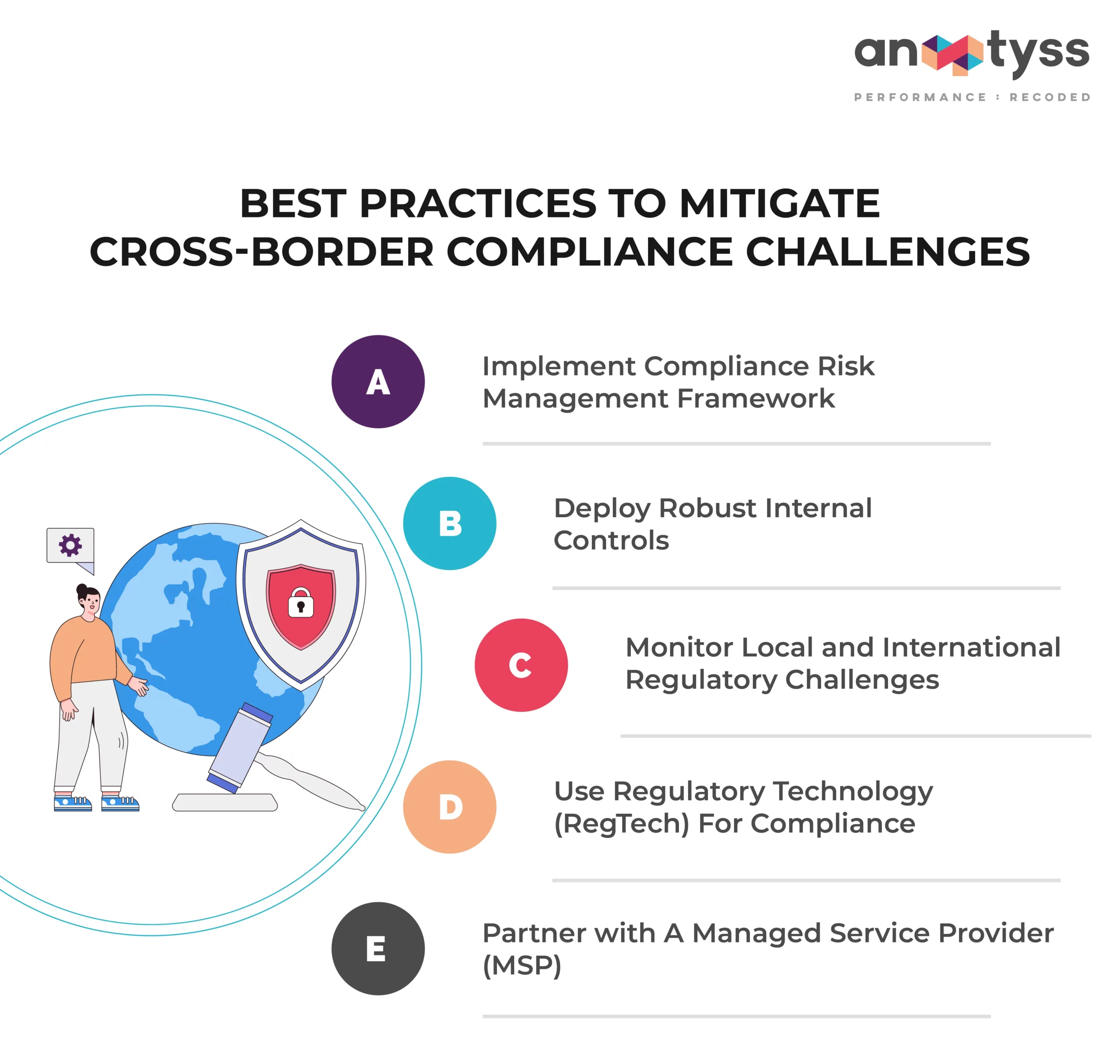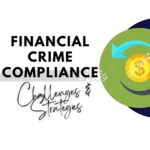Financial institutions face significant challenges in managing cross-border regulatory compliance due to diverse and evolving regulatory frameworks, cultural differences, data privacy issues, and resource constraints. This blog discusses these challenges and offers best practices, including compliance risk management, robust internal controls, regulatory monitoring, leveraging RegTech, and partnering with managed service providers to navigate the complexities effectively.
Financial institutions often encounter vast compliance challenges while operating in the domestic market. The regulatory challenges become even more complex for financial institutions with a global presence or conducting cross-border operations.
To navigate the global regulatory compliance landscape, many banks and financial service institutions still rely on manual processes, which are prone to errors and conflicts and consume time.
This blog discusses the challenges of managing cross-border regulatory compliance and best practices for banks to effectively navigate these challenges while enhancing customer experience (CX) and employee satisfaction.
What is Cross-Border Compliance?
Cross-border compliance refers to the practice of adhering to laws, regulations, and standards when conducting banking operations across national boundaries. The primary objective of cross-border compliance spans the following aspects:
- Adherence to territorial regulations globally as applicable
- Management and mitigation of risks
- Prevention of money laundering and terrorist financing
- Protection of data and privacy
- Ensuring a positive global reputation
Why is Cross-Border Regulatory Compliance Important?
Cross-border compliance is crucial for financial institutions that are expanding to other jurisdictions or operating internationally. Compliance with the prevalent laws, standards, and regulations of local jurisdictions in which the bank or financial institution operates helps them in the following ways:
- Enhances global reputation
- Diversifies the risks
- Enables competitive advantage
- Ensures financial stability by avoiding fines and penalties
- Builds strategic partnerships
- Promotes ethical workplace culture
In contrast, failure to comply with regulations can lead to severe consequences, including:
- Fines and penalties
- Economic consequences
- Reputational damage
- Legal action
- Loss of customers and market share
The 4 Key Challenges to Cross-Border Regulatory Compliance
Meeting cross-border regulatory compliance can be challenging due to the differences in laws, regulations, and cultural norms and increased scrutiny by regulatory bodies across the globe.
Financial institutions face the following prominent challenges to cross-border compliance:
1. Rapidly Changing Diverse Regulatory Frameworks
One of the most crucial challenges with cross-border compliance is the ever-evolving financial services regulatory frameworks.
Each country has its regulatory requirements and frameworks that are subject to frequent updates based on technological advancements, market shifts, societal expectations, employment laws, and emerging risks. Understanding and adhering to these varying regulatory compliance requirements can be daunting, complex, and time-consuming for multi-national financial institutions.
2. Language, Cultural, and Ethical Differences
Due to cultural, language, and ethical differences, regulatory documents and communications are often not clear, which leaves room for ambiguity and leads to misunderstanding and misalignment between the financial institutions and the regulatory authorities in different jurisdictions.
Misinterpretation and miscommunication related to legal documents or contacts can have gross consequences. In addition, certain business practices in one jurisdiction or country may not be acceptable or illegal in another. This can further lead to miscommunication, reputational damage, legal issues, and compliance failures.
3. Data Privacy and Cybersecurity
Cross-border data transfer and handling of sensitive and confidential customer data pose another significant compliance challenge.
Banks and financial institutions must comply with data protection regulations, such as the GDPR, that can be stringent and have extraterritorial reach. However, keeping up with these constantly evolving data privacy and cybersecurity laws can be daunting for financial institutions, which may also lead to conflicts due to different regulations in different jurisdictions.
4. Resource and Supply Chain Constraints
Compliance efforts require dedicated resources. This could be a challenge for many banks and financial institutions, especially SMEs, that may find it challenging to allocate sufficient resources to meet the cross-border regulatory requirements effectively.
Global supply chains are intricate and involve multiple suppliers and partners across borders. Ensuring compliance with the supply chain can be challenging if they are in jurisdictions with regulatory laws and standards.
Top 5 Best Practices to Mitigate Cross-Border Compliance Challenges
By taking these steps, organizations can improve their ability to overcome cross-border compliance challenges, effectively manage risk, mitigate breaches, and ensure compliance with applicable laws and regulations in the jurisdictions where they operate. To effectively navigate the complexities of the global business environment, maintaining a commitment to compliance, ongoing monitoring, and continuous improvement is essential.
1. Compliance Risk Management
Compliance risk management (CRM) is a process of identifying, analyzing, and monitoring risks to banks’ compliance status. With an effective enterprise risk management framework, financial institutions can effectively identify and assess potential risks, including cross-border compliance risks and challenges, that are specific to the business or organization and the jurisdiction where they are operating. While assessing the compliance risks, consider the following factors:
- AML/CTF requirements
- Regulatory variations
- Cultural and ethical factors
- Data privacy and data security laws
- Political stability
- Supply chain risks
2. Robust Internal Controls
Internal controls for monitoring, auditing, and reporting help banks and financial institutions detect non-compliance and prevent compliance violations. Design internal controls to specifically address the cross-border compliance issues.
Also, regular control testing is critical to ensure that the internal controls are robust and effective in mitigating cross-border compliance risks. Control testing also helps detect the existing and emerging gaps and weaknesses in the internal controls and updates them to mitigate cross-border compliance risks. You can follow the 10 best practices for internal control testing and learn the key steps to implement a control testing program.
3. Monitor Regulatory Challenges
Regular monitoring of changes in compliance and regulatory requirements and being aware of the changes in the laws or standards in the jurisdictions is crucial for financial institutions to deal with and be agile in adapting cross-border compliance changes or frameworks. Financial institutions can:
- Establish a dedicated team or assign specific individuals to constantly monitor, analyze, and communicate the regulatory changes.
- Use regulatory intelligence tools or services to stay updated in real time on regulatory changes
- Conduct regular risk assessments
4. Use Regulatory Technology (RegTech) for Compliance
Financial institutions must leverage regulatory technologies, such as advanced data analytics, AI, ML, blockchain, etc. to streamline their compliance management. Below are some examples of how financial institutions can leverage these technologies in managing different aspects of compliance management.
- Use advanced data analytics to analyze vast datasets and detect anomalies and potential compliance risks related to customers and transactions (AML/CTF).
- Use predictive analysis tools to anticipate regulatory changes by analyzing historical data.
- Use machine-learning-based AML transaction monitoring tools to identify suspicious activities with higher accuracy.
- Use blockchain to trace cross-border transactions and enhance transparency.
- Create a centralized channel to ensure open communication and cooperation with regulatory authorities in different jurisdictions.
5. Partner with a Managed Service Provider (MSP)
Managed services provider can help financial institutions streamline their financial services and ensure compliance with industry regulations. By partnering with MSPs, financial institutions can have immediate access to global regulatory expertise that can help them stay updated about the regulatory changes across different jurisdictions.
They also provide 24/7 support with continuous monitoring of regulatory changes, conduct comprehensive risk assessments to identify potential compliance gaps and conduct due diligence on customers, partners, and entities involved in cross-border transactions, which is crucial to meet AML/CTF and BSA regulations.
However, there are several considerations that a financial institution needs to take into account while choosing the right managed service provider that meets their requirements and helps them effectively address compliance challenges.
Conclusion
Cross-border compliance presents unique challenges for financial institutions operating in different countries or states. To effectively navigate the cross-border regulatory compliance challenges and meet financial crime compliance (FCC) requirements of different jurisdictions, financial institutions require a proactive and strategic approach.
Anaptyss is helping financial institutions across the globe with their Digital Knowledge Operations™ framework that helps you transform your front, middle, and back office business and technology operations in financial services and meet cross-border financial crime compliance.
To learn how DKO™ can help your financial institution address cross-border compliance challenges, reach out to us at: info@anaptyss.com


















